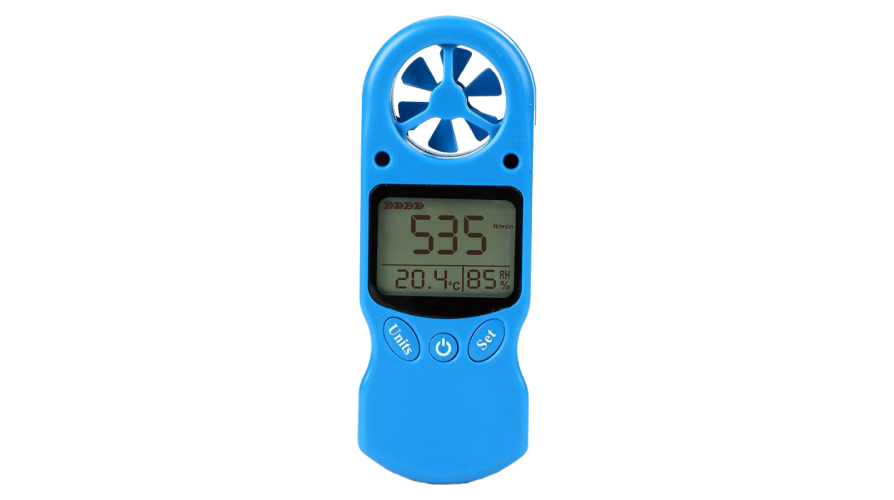Comprehending Different Types of Anemometers for Various Applications
Comprehending Different Types of Anemometers for Various Applications
Blog Article
All You Need to Understand About Anemometers: Just How They Work, Why They Matter, and Where to Make use of Them
Anemometers, though typically overlooked in the realm of scientific tools, play a critical function in numerous fields, using valuable insights into wind speed and air flow patterns. As we dive into the ins and outs of anemometer modern technology, we will certainly reveal the inner workings of these devices, their value, and the essential factors to consider when picking the appropriate anemometer for certain applications.

Anemometer Fundamentals
An important tool made use of to determine wind rate and direction, the anemometer plays an important role in weather forecasting and different markets. An anemometer usually consists of 3 or four mugs that turn in the wind, a vane that aims into the wind, and sensing units to track the rotations or movements.
There are various types of anemometers readily available, including mug anemometers, vane anemometers, hot-wire anemometers, and sonic anemometers, each with its unique functions and applications. Mug anemometers are frequently used for basic wind speed dimensions, while vane anemometers are preferred for directional measurements.
Principles of Anemometer Procedure
Building on the foundational understanding of anemometer fundamentals, the concepts of anemometer operation elucidate the mechanics behind wind speed and direction measurements. Anemometers run on the concept of airflow impacting a sensor, triggering it to revolve. Mug anemometers, for instance, have three or even more mugs that catch the wind, creating them to rotate faster as the wind speed increases. The rotation rate is after that transformed right into a wind rate dimension. Vane anemometers, on the other hand, use a tail or a probe that aligns itself with the wind instructions, supplying a dimension of wind instructions based upon the alignment of the sensor. Hot-wire anemometers depend on a heated wire that cools down as wind passes over it, with the price of cooling establishing the wind rate. Ultrasonic anemometers procedure wind rate and instructions by assessing the moment it considers ultrasonic signals to take a trip in between transducers. Comprehending these principles is critical for accurate and reliable wind measurements in various applications.
Relevance of Anemometers
Anemometers play an essential function in determining wind rate and Related Site direction, supplying important data for weather condition projecting, environment research studies, ecological surveillance, and air travel operations. Meteorologists rely on anemometers to gather accurate wind information, helping them understand climate patterns, anticipate tornados, and concern prompt warnings to the public. Wind farm operators utilize anemometers to evaluate wind conditions and optimize electricity manufacturing from wind turbines.
Applications Across Various Industries
In the sustainable power sector, anemometers play an essential function in assessing wind problems for wind farm placements, making certain optimal power production. Industries Full Article like construction and mining use anemometers to monitor wind speeds, critical for safety procedures, particularly when functioning at elevations or in open-pit mines where strong winds can position risks. In farming, anemometers aid farmers in taking care of plant splashing by supplying real-time information on wind rate to prevent drift.

Choosing the Right Anemometer for Your Needs
Choosing the proper anemometer tailored to your specific demands is crucial for getting precise wind rate and instructions measurements. When selecting an anemometer, consider aspects such as the designated application, needed dimension array, environmental conditions, and desired functions. For general purposes, a cup anemometer appropriates for determining wind speed, while a vane anemometer offers wind direction data. Hot-wire anemometers are excellent for reduced airspeed dimensions, and ultrasonic anemometers provide high precision and durability.

Conclusion
In final thought, anemometers play a crucial function in gauging wind speed and direction throughout various industries. It is crucial to take into consideration the relevance of anemometers in order to make informed decisions when selecting the most appropriate tool for gauging wind conditions.
There are different kinds of anemometers readily available, including mug anemometers, vane anemometers, hot-wire anemometers, and sonic anemometers, each with its unique functions and applications. Mug anemometers are commonly used for fundamental wind rate dimensions, while vane anemometers are chosen for directional measurements. Hot-wire anemometers are appropriate for low airspeeds, and sonic anemometers are excellent for high-precision dimensions in study and commercial settings.Structure on the foundational understanding of anemometer fundamentals, the principles of anemometer procedure elucidate the technicians behind wind rate and direction measurements. For general functions, a cup anemometer is appropriate for determining wind rate, while a vane anemometer provides wind direction data.
Report this page